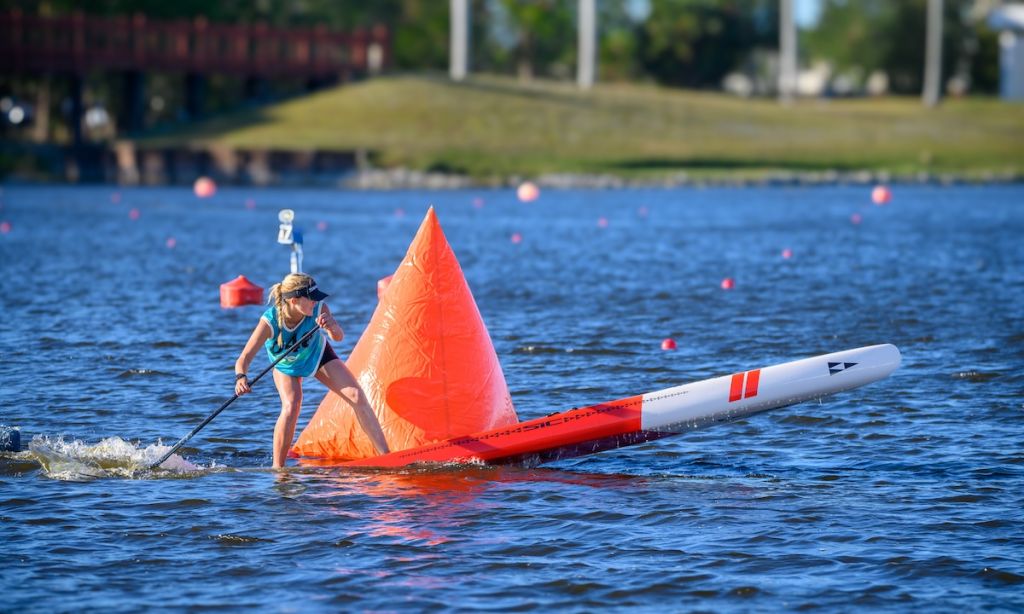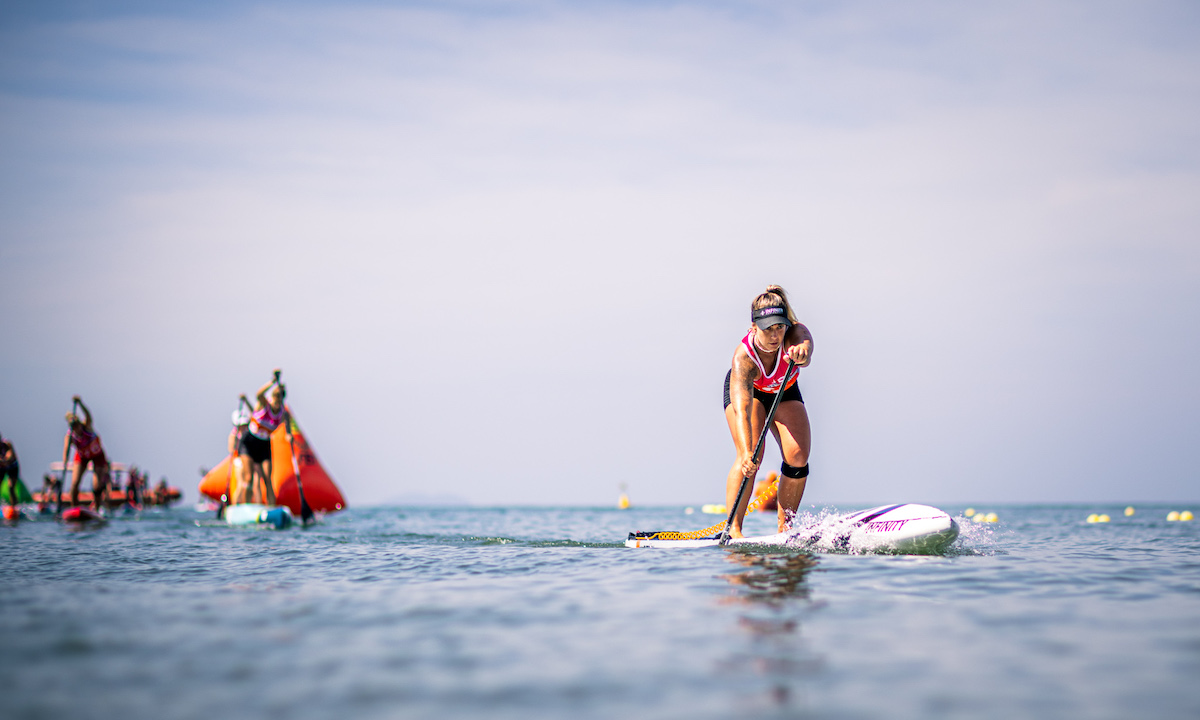One-Design Rule for Junior SUP Racers—A Game-Changer or a Setback?
- Written by Staff
- Published in News
- Comments::DISQUS_COMMENTS
 Rising star, junior athlete Soryn Preston, at the 2024 ICF World SUP Championships. | Photo: SIC Maui / Charles Dasher
Rising star, junior athlete Soryn Preston, at the 2024 ICF World SUP Championships. | Photo: SIC Maui / Charles Dasher
In a sweeping move aimed at leveling the playing field and reducing the financial burden on junior competitors, the International Canoe Federation (ICF) has introduced a new rule mandating that all junior participants at the World Championships must race on a standardized, one-design ICF SUP board (14-foot). By removing expensive equipment considerations, the ICF hopes to lower barriers to entry and make competitive paddling more accessible to a diverse range of young athletes.
On its face, this rule could be heralded as a positive step forward for the sport, particularly for those who struggle to keep pace with skyrocketing equipment costs. For parents and juniors already juggling travel and training expenses, the reassurance that they can simply pack their paddles—and not incur high transport fees for large boards—can be a relief. It simplifies logistics, reduces shipping nightmares, and helps ensure that every young athlete has an equal opportunity on race day, regardless of their financial resources.
Yet for all its good intentions, the regulation has not come without controversy. Some seasoned junior paddlers, including competitor Soryn Preston, have decided to withdraw from future ICF events rather than switch to the mandated board. At first glance, this might seem like an overreaction to a rule rooted in fairness and accessibility. However, it highlights an important concern: competitive standup paddling is not just about leveling the financial playing field; it is also about expertise, brand relationships, and equipment familiarity. Many junior athletes develop a sense of confidence and identity with their chosen boards, fine-tuning their performance over countless hours of training.
A Uniform Platform vs. Individualized Performance
For those who have grown attached to their personal setups—and often rely on specific board geometry to maximize their stroke techniques—being asked to adjust to a one-size-fits-all solution can feel like a loss of control. The shift may also impede valuable equipment testing, sponsored collaborations, and the broader culture of innovation that has historically driven the SUP industry forward.
A standardized board could inadvertently disadvantage taller or heavier paddlers, or those who have refined paddling styles specific to certain board dimensions. Although the 14-foot design aims for broad suitability, it inevitably overlooks individual preference and biomechanical nuances—though defenders of the rule would argue that this is precisely what makes it a fairer standard.
Financial Accessibility vs. Competitive Diversity
The new rule admirably tackles the problem of cost. Standup paddling, like many water sports, can be expensive, and cutting out board-related transportation and purchase fees is a significant equalizer. Moreover, it sends a strong signal: The ICF sees the junior category as an entry point for the next generation, and they are willing to shake up the norm to make it more inclusive.
However, the debate on whether uniform equipment will stifle competition remains unresolved. An unexpected consequence could be fewer junior participants in certain events, as young athletes with sponsor relationships or a preference for their own boards opt out. In the long run, the rule’s strictness may need revisiting if it results in more defections like Preston’s, especially if these athletes are among the highest-profile talents with promising careers ahead.
 2x Junior ICF Champion from 2023, Claudia Postiglione. | Photo: ICF / Georgia Schofield
2x Junior ICF Champion from 2023, Claudia Postiglione. | Photo: ICF / Georgia Schofield
Where Does the Sport Go From Here?
Rules that aim for accessibility can still yield unintended outcomes. From a development standpoint, the idea of an “equal board for all” might attract new paddlers who were previously deterred by cost—a worthwhile goal if the ICF wants the sport to grow globally. The organization must monitor how these regulations actually impact participation levels, sponsorship dynamics, and athlete satisfaction in the coming seasons.
It is also important to note that the specifications of the one-design program are yet to be determined, leaving some athletes in limbo about how this new rule will be enforced in practice. For now, there are more questions than answers, and any immediate concerns—such as potential disadvantages for certain body types or the culture of innovation in the sport—remain unresolved. We have reached out to the ICF and associated individuals for comment but have not yet received a response, leaving the community eagerly awaiting further clarity.
Should a standardized board requirement remain in place permanently? It might depend on how well the ICF can collaborate with racers, coaches, and board manufacturers to ensure that quality, safety, and fairness go hand in hand. One option could be a hybrid approach: allowing personal boards in some competitions while maintaining the one-design rule for specific junior categories or championships. That way, newcomers can still experience an affordable entry pathway, while more advanced junior racers maintain the freedom to refine their personal craft and progress at higher levels.
Conclusion
The ICF’s decision represents a pivotal moment for junior standup paddling. While the one-design requirement addresses pressing cost concerns and promises a streamlined, equitable stage for all, it could dampen the competitive spirit and disrupt established athlete-sponsor relationships. The withdrawal of paddlers like Soryn Preston is an early indicator of the policy’s potential pitfalls.
In navigating this new landscape, the ICF should remain open to dialogue and flexible in adapting the rule if it proves to discourage more juniors than it invites. Striking the right balance—between affordability and the artistry of individualized equipment—will be crucial for the healthy development of the sport and for securing the future of these young paddlers who represent its next generation of champions.
As this story continues to unfold, we will provide updates on official responses, clarified board specifications, and the potential long-term implications for youth SUP racing.
For more SUP news, click HERE.

Staff
Submit your news, events, and all SUP info, so we can keep promoting and driving the great lifestyle of stand up paddling, building its community, and introducing people to healthier living.
Website: supconnect.com Email This email address is being protected from spambots. You need JavaScript enabled to view it.




